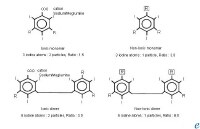Since their introduction in the 1950s, organic radiographic iodinated contrast media (ICM) have been among the most commonly prescribed drugs in the history of modern medicine. The phenomenon of present-day radiologic imaging would be lacking without these agents. ICM generally have a good safety record. Adverse effects from the intravascular administration of ICM are generally mild and self-limited; reactions that occur from the extravascular use of ICM are rare.[1]Nonetheless, severe or life-threatening reactions can occur with either route of administration.[2, 3, 4, 5, 6, 7, 8, 9, 10, 11, 12, 13]
For ICM classifications, see the image below.
 Classification of iodinated contrast agents by their molecular structures.
Classification of iodinated contrast agents by their molecular structures.
Radiologists and other physicians must be aware of the risk factors for reactions to contrast media, use strategies to minimize adverse events, and be prepared to promptly recognize and manage any reactions to the contrast media.[14, 15, 16, 17, 18]
Skin testing
Brockow et al performed a prospective study to determine the specificity and sensitivity of skin tests in patients who have experienced contrast-related reactions and found that skin test specificity was 96-100%. Skin prick, intradermal, and patch tests were conducted in 220 patients with either immediate or nonimmediate reaction. For immediate reactors, the intradermal tests were the most sensitive, whereas delayed intradermal tests in combination with patch tests were needed for optimal sensitivity in nonimmediate reactors. Contrast medium cross-reactivity was more common in the nonimmediate than in the immediate group. The data suggested that at least 50% of hypersensitivity reactions to contrast media are caused by an immunologic mechanism. Skin testing appears to be a useful tool for diagnosis of contrast medium allergy and may play an important role in selection of a safe product in previous reactors.[13]
No comments:
Post a Comment